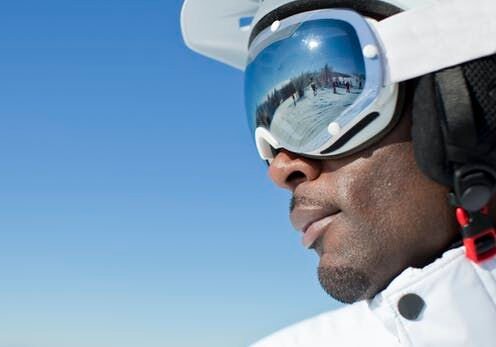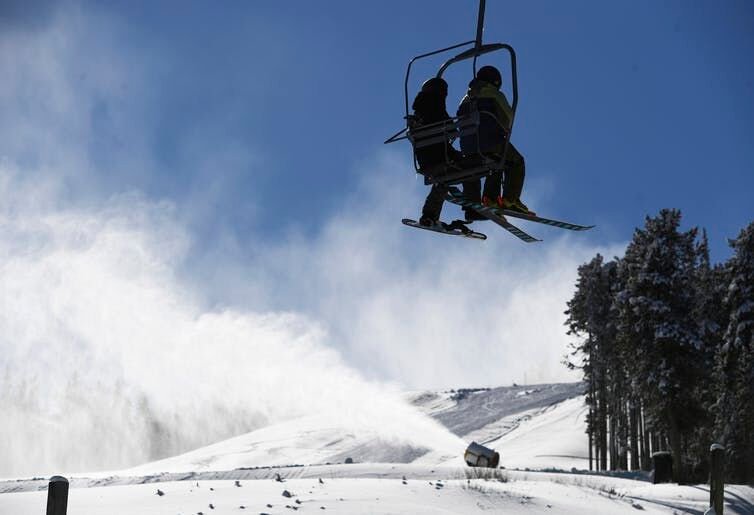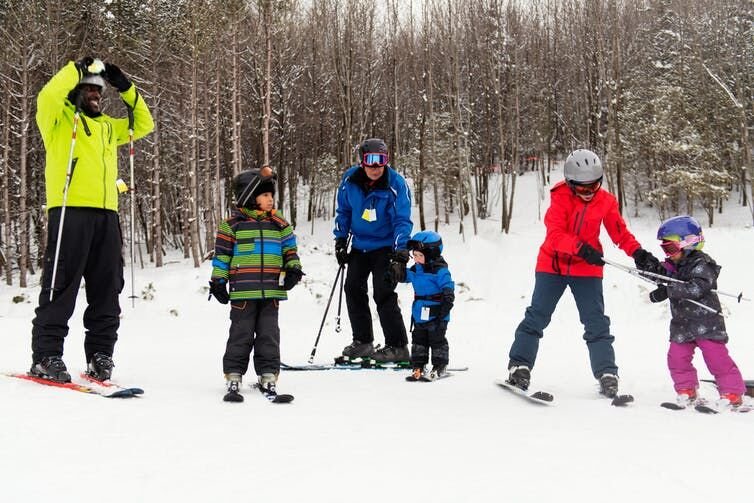
Watching skiers compete almost entirely on artificially made snow at the 2022 Winter Olympics, we found it hard not to think about climate change and what it will mean for the future of the winter sports industry — and who will be able to participate.
Ski areas are increasingly reliant on extensive snowmaking operations to keep their slopes open as the planet warms. A few degrees of warming can mean more days of rain instead of snow and shorter seasons. That reduces the operators’ revenue and raises their costs.
Those costs, passed along to visitors in higher lift ticket and resort prices, directly affect who can afford to spend a day on the slopes skiing or snowboarding.
As resorts’ costs rise, these already expensive sports risk becoming more exclusive and less diverse.
Our research involves what’s known as intersectional sustainability in sports — looking at how to ensure they are both inclusive and environmentally sustainable. For ski resorts, intersectional sustainability means acknowledging that climate change may result in the unintended consequence of further entrenching the sports’ lack of diversity, and proactively seeking to prevent that.
Adaptation is necessary, and expensive
Creating artificial snow to adapt to climate change doesn’t come cheap.
Holiday Valley, a small resort in Ellicottville, New York, has invested over $13 million in snowmaking equipment in the past 40 years. On top of that are the costs of energy, labor and piping in thousands of gallons of water a minute to run snowmaking machines. Even as snowmaking machines become more efficient, the overall cost is still significant.

An analysis of the outlook for Blue Mountain, a ski resort in Ontario, Canada, offers a glimpse of the future.
In a best-case scenario, if the world achieves the Paris climate agreement goal of limiting warming to under 2 degrees Celsius (3.6 F), Blue Mountain’s ski season is to likely shorten by 8% and its snowmaking efforts would have to almost double by 2050. The window of ideal weather for snowmaking would also reduce by 22%, meaning the resort would be making snow under less efficient conditions, which further drives up the cost. Those extra costs likely will show up in higher lift ticket and resort prices.
Smaller resorts may be forced to take on debt to finance snowmaking equipment. High leverage ratios have been shown to reduce profitability for ski resorts. Some smaller ski areas have shut down, leaving fewer nearby options for skiing and snowboarding in some areas and reducing competition that could help keep prices in check.
Resorts already struggle with diversity
Alpine skiing and snowboarding resorts already draw criticism for their lack of diversity.
In 2019-20, 69% of visitors who described themselves as skiers and 61% as snowboarders identified as Caucasian or white, according to Snowsports Industries of America. The organization found the most frequent participants are even less diverse.
A separate survey by the National Ski Area Association found a wider difference: 87.5% of U.S. visits that season were individuals identifying as Caucasian or white, and only 1.5% were people identifying as Black or African American.
The Snowsports Industries of America survey also found a wealth gap. More than 63% of skiers and 55% of snowboarders had an income over $75,000, almost double the median earnings of Americans.

Some resort corporations, including Aspen Snowmass and Powdr, have committed to increasing diversity and inclusion at their resorts. Powdr, for example, has community initiatives in its “Play Forever” campaign that include awarding scholarships to help people attend their camps and a partnership with STOKED, a nonprofit that mentors young people from underserved communities who are interested in board sports.
But among several other corporate-owned ski resorts, there is a noticeable lack of diversity efforts on their corporate websites. Eight resort companies included either no mention of diversity and inclusion or provided no evidence of initiatives supporting these efforts on their corporate websites.
The results suggest to us that the rising costs of climate adaptation will leave many would-be skiers and snowboarders unable to enjoy the sports.
Three tactics to improve diversity for the future
As the climate changes, management practices can also change to keep the slopes accessible.
One effective strategy is engaging and partnering with community organizations that focus on diversity and inclusion. By working with organizations engaged in the community, Powdr can connect with disadvantaged youth and introduce them to snowboarding and skiing, for example.
[Over 150,000 readers rely on The Conversation’s newsletters to understand the world. Sign up today.]
Ski resorts can also engage directly with nonprofits like the National Brotherhood of Skiers, whose mission is to develop and support athletes of color in winter sports, and communities that are underrepresented on the mountain to understand how decisions related to climate adaptation may have the unintended consequence of further entrenching inequalities.
Resort corporations can also improve their connections with diverse communities by increasing the diversity of leadership and creating senior leadership positions in charge of diversity, equity and inclusion initiatives.
By including diverse communities in the climate adaptation discussion, ski resorts have a better chance of achieving a future where snow sports are more accessible for everyone.
Brian P. McCullough is also the Co-Director of the Sport Ecology Group.
Lance Warwick does not work for, consult, own shares in or receive funding from any company or organization that would benefit from this article, and has disclosed no relevant affiliations beyond their academic appointment.
This article is republished from The Conversation under a Creative Commons license.
-
Rising costs of climate change threaten to make skiing a less diverse, even more exclusive sport
Natacha Pisarenko
Eliska Brezinova, of the Czech Republic, finger nails are seen after the women's short program during the figure skating at the 2022 Winter Olympics, Tuesday, Feb. 15, 2022, in Beijing. (AP Photo/Natacha Pisarenko)
Natacha Pisarenko
Eliska Brezinova, of the Czech Republic, finger nails are seen after the women's short program during the figure skating at the 2022 Winter Olympics, Tuesday, Feb. 15, 2022, in Beijing. (AP Photo/Natacha Pisarenko)
-
Rising costs of climate change threaten to make skiing a less diverse, even more exclusive sport
Bernat Armangue
Brendan Corey of Australia, prepares for his quarterfinal of the men's 1,000-meter during the short track speedskating competition at the 2022 Winter Olympics, Monday, Feb. 7, 2022, in Beijing. (AP Photo/Bernat Armangue)
Bernat Armangue
Brendan Corey of Australia, prepares for his quarterfinal of the men's 1,000-meter during the short track speedskating competition at the 2022 Winter Olympics, Monday, Feb. 7, 2022, in Beijing. (AP Photo/Bernat Armangue)
-
-
Rising costs of climate change threaten to make skiing a less diverse, even more exclusive sport
Lee Jin-man
Canada's Elizabeth Hosking reacts during the women's halfpipe finals at the 2022 Winter Olympics, Thursday, Feb. 10, 2022, in Zhangjiakou, China. (AP Photo/Lee Jin-man)
Lee Jin-man
Canada's Elizabeth Hosking reacts during the women's halfpipe finals at the 2022 Winter Olympics, Thursday, Feb. 10, 2022, in Zhangjiakou, China. (AP Photo/Lee Jin-man)
-
Rising costs of climate change threaten to make skiing a less diverse, even more exclusive sport
Brynn Anderson
United States' Rebecca Hamilton holds a curling broom with a tattoo of the Olympics Rings during a women's curling match against the Russian Olympic Committee at the Beijing Winter Olympics Monday, Feb. 14, 2022, in Beijing. (AP Photo/Brynn Anderson)
Brynn Anderson
United States' Rebecca Hamilton holds a curling broom with a tattoo of the Olympics Rings during a women's curling match against the Russian Olympic Committee at the Beijing Winter Olympics Monday, Feb. 14, 2022, in Beijing. (AP Photo/Brynn Anderson)
-
-
Rising costs of climate change threaten to make skiing a less diverse, even more exclusive sport
Brynn Anderson
South Korea's Kim Kyeong-ae has Bing Dwen Dwen, the Olympics mascot, on her nails during a women's curling match against Britain at the Beijing Winter Olympics Friday, Feb. 11, 2022, in Beijing. (AP Photo/Brynn Anderson)
Brynn Anderson
South Korea's Kim Kyeong-ae has Bing Dwen Dwen, the Olympics mascot, on her nails during a women's curling match against Britain at the Beijing Winter Olympics Friday, Feb. 11, 2022, in Beijing. (AP Photo/Brynn Anderson)
-
Rising costs of climate change threaten to make skiing a less diverse, even more exclusive sport
Kirsty Wigglesworth
A shell casing is ejected during biathlon target shooting at the 2022 Winter Olympics, Friday, Feb. 4, 2022, in Zhangjiakou, China. (AP Photo/Kirsty Wigglesworth)
Kirsty Wigglesworth
A shell casing is ejected during biathlon target shooting at the 2022 Winter Olympics, Friday, Feb. 4, 2022, in Zhangjiakou, China. (AP Photo/Kirsty Wigglesworth)
-
-
Rising costs of climate change threaten to make skiing a less diverse, even more exclusive sport
Lee Jin-man
China's Qiu Leng holds up her hands with words of encouragement during the women's halfpipe finals at the 2022 Winter Olympics, Thursday, Feb. 10, 2022, in Zhangjiakou, China. (AP Photo/Lee Jin-man)
Lee Jin-man
China's Qiu Leng holds up her hands with words of encouragement during the women's halfpipe finals at the 2022 Winter Olympics, Thursday, Feb. 10, 2022, in Zhangjiakou, China. (AP Photo/Lee Jin-man)
-
Rising costs of climate change threaten to make skiing a less diverse, even more exclusive sport
Mark Schiefelbein
Makena Hodgson, of Canada, holds the handle prior to the luge women's singles run 3 at the 2022 Winter Olympics, Tuesday, Feb. 8, 2022, in the Yanqing district of Beijing. (AP Photo/Mark Schiefelbein)
Mark Schiefelbein
Makena Hodgson, of Canada, holds the handle prior to the luge women's singles run 3 at the 2022 Winter Olympics, Tuesday, Feb. 8, 2022, in the Yanqing district of Beijing. (AP Photo/Mark Schiefelbein)
-
-
Rising costs of climate change threaten to make skiing a less diverse, even more exclusive sport
Brynn Anderson
Denmark's Mathilde Halse wears the Olympics Rings necklace during a women's curling match against Japan at the Beijing Winter Olympics Saturday, Feb. 12, 2022, in Beijing. (AP Photo/Brynn Anderson)
Brynn Anderson
Denmark's Mathilde Halse wears the Olympics Rings necklace during a women's curling match against Japan at the Beijing Winter Olympics Saturday, Feb. 12, 2022, in Beijing. (AP Photo/Brynn Anderson)
-
Rising costs of climate change threaten to make skiing a less diverse, even more exclusive sport
Natacha Pisarenko
Marjorie Lajoie and Zachary Lagha, of Canada, perform their routine in the ice dance competition during figure skating at the 2022 Winter Olympics, Saturday, Feb. 12, 2022, in Beijing. (AP Photo/Natacha Pisarenko)
Natacha Pisarenko
Marjorie Lajoie and Zachary Lagha, of Canada, perform their routine in the ice dance competition during figure skating at the 2022 Winter Olympics, Saturday, Feb. 12, 2022, in Beijing. (AP Photo/Natacha Pisarenko)
-
-
Rising costs of climate change threaten to make skiing a less diverse, even more exclusive sport
Pavel Golovkin
Kaillie Humphries, of United States, starts women's monobob heat 1 at the 2022 Winter Olympics, Sunday, Feb. 13, 2022, in the Yanqing district of Beijing. (AP Photo/Pavel Golovkin)
Pavel Golovkin
Kaillie Humphries, of United States, starts women's monobob heat 1 at the 2022 Winter Olympics, Sunday, Feb. 13, 2022, in the Yanqing district of Beijing. (AP Photo/Pavel Golovkin)
-
Rising costs of climate change threaten to make skiing a less diverse, even more exclusive sport
Bernat Armangue
Victoria Sinitsina and Nikita Katsalapov, of the Russian Olympic Committee, perform their routine in the ice dance competition during figure skating at the 2022 Winter Olympics, Saturday, Feb. 12, 2022, in Beijing. (AP Photo/Bernat Armangue)
Bernat Armangue
Victoria Sinitsina and Nikita Katsalapov, of the Russian Olympic Committee, perform their routine in the ice dance competition during figure skating at the 2022 Winter Olympics, Saturday, Feb. 12, 2022, in Beijing. (AP Photo/Bernat Armangue)
-
-
Rising costs of climate change threaten to make skiing a less diverse, even more exclusive sport
Gerald Herbert
Gold medalist Birk Ruud of Norway celebrates during the medal ceremony for the men's freestyle skiing big air at the 2022 Winter Olympics, Wednesday, Feb. 9, 2022. (AP Photo/Gerald Herbert)
Gerald Herbert
Gold medalist Birk Ruud of Norway celebrates during the medal ceremony for the men's freestyle skiing big air at the 2022 Winter Olympics, Wednesday, Feb. 9, 2022. (AP Photo/Gerald Herbert)
-
Rising costs of climate change threaten to make skiing a less diverse, even more exclusive sport
Brynn Anderson
Zuzana Paulova, of the Czech Republic, wears curling stone earrings during the mixed doubles curling match against the United States at the Beijing Winter Olympics Sunday, Feb. 6, 2022, in Beijing. (AP Photo/Brynn Anderson)
Brynn Anderson
Zuzana Paulova, of the Czech Republic, wears curling stone earrings during the mixed doubles curling match against the United States at the Beijing Winter Olympics Sunday, Feb. 6, 2022, in Beijing. (AP Photo/Brynn Anderson)
-
-
Rising costs of climate change threaten to make skiing a less diverse, even more exclusive sport
Brynn Anderson
An Olympic ice maker holds a pebble head covered with water droplets used for making the curling sheet ice surface during a women's round robin curling match at the Beijing Winter Olympics, Thursday, Feb. 10, 2022, in Beijing. (AP Photo/Brynn Anderson)
Brynn Anderson
An Olympic ice maker holds a pebble head covered with water droplets used for making the curling sheet ice surface during a women's round robin curling match at the Beijing Winter Olympics, Thursday, Feb. 10, 2022, in Beijing. (AP Photo/Brynn Anderson)
-
Rising costs of climate change threaten to make skiing a less diverse, even more exclusive sport
Brynn Anderson
Japan's Satsuki Fujisawa runs her fingers through her hair and a message to herself written on her hand "I'm a good curler. I have confidence. Let's have fun!" during a women's curling match against China at the Beijing Winter Olympics Monday, Feb. 14, 2022, in Beijing. (AP Photo/Brynn Anderson)
Brynn Anderson
Japan's Satsuki Fujisawa runs her fingers through her hair and a message to herself written on her hand "I'm a good curler. I have confidence. Let's have fun!" during a women's curling match against China at the Beijing Winter Olympics Monday, Feb. 14, 2022, in Beijing. (AP Photo/Brynn Anderson)
-
-
Rising costs of climate change threaten to make skiing a less diverse, even more exclusive sport
Natacha Pisarenko
Track officials pour water on the track during the short track speedskating competition at the 2022 Winter Olympics, Wednesday, Feb. 9, 2022, in Beijing. (AP Photo/Natacha Pisarenko)
Natacha Pisarenko
Track officials pour water on the track during the short track speedskating competition at the 2022 Winter Olympics, Wednesday, Feb. 9, 2022, in Beijing. (AP Photo/Natacha Pisarenko)
-
Rising costs of climate change threaten to make skiing a less diverse, even more exclusive sport
Francisco Seco
A volunteer fashions a rubber duck on the top of his helmet during the women's halfpipe finals at the 2022 Winter Olympics, Thursday, Feb. 10, 2022, in Zhangjiakou, China. (AP Photo/Francisco Seco)
Francisco Seco
A volunteer fashions a rubber duck on the top of his helmet during the women's halfpipe finals at the 2022 Winter Olympics, Thursday, Feb. 10, 2022, in Zhangjiakou, China. (AP Photo/Francisco Seco)



